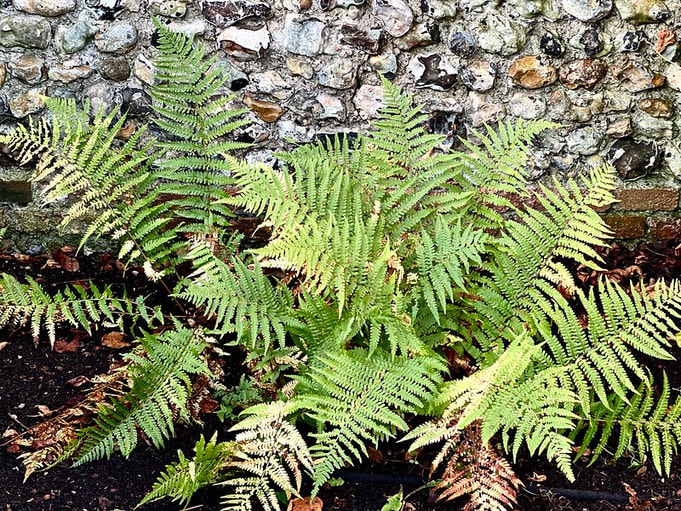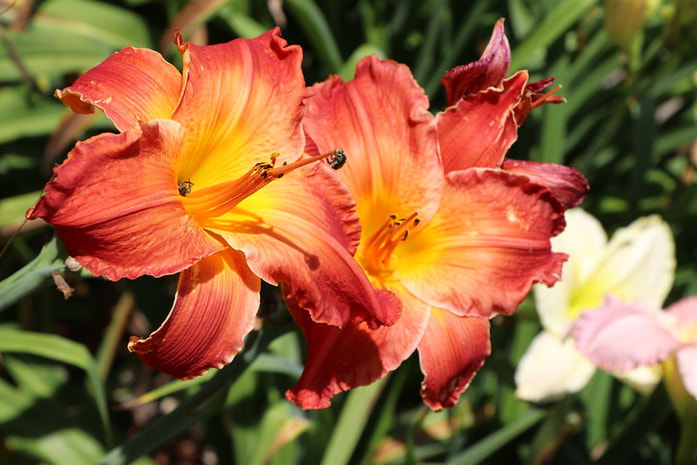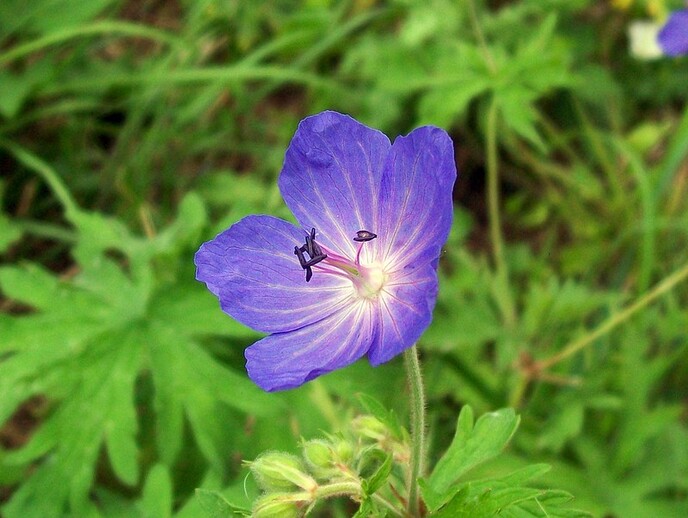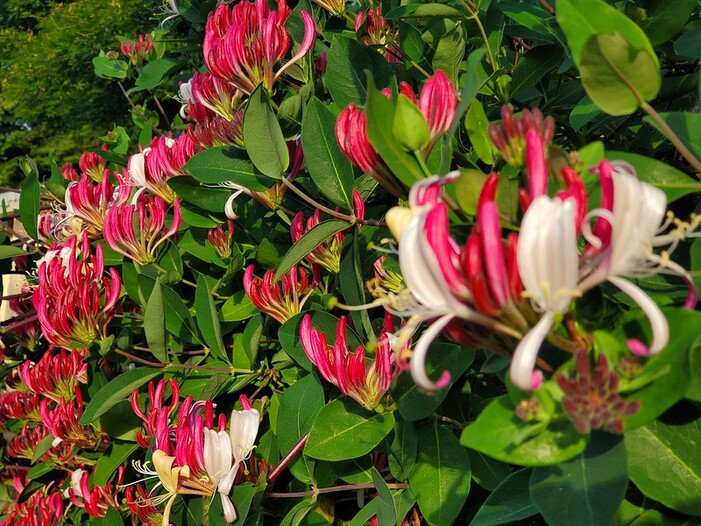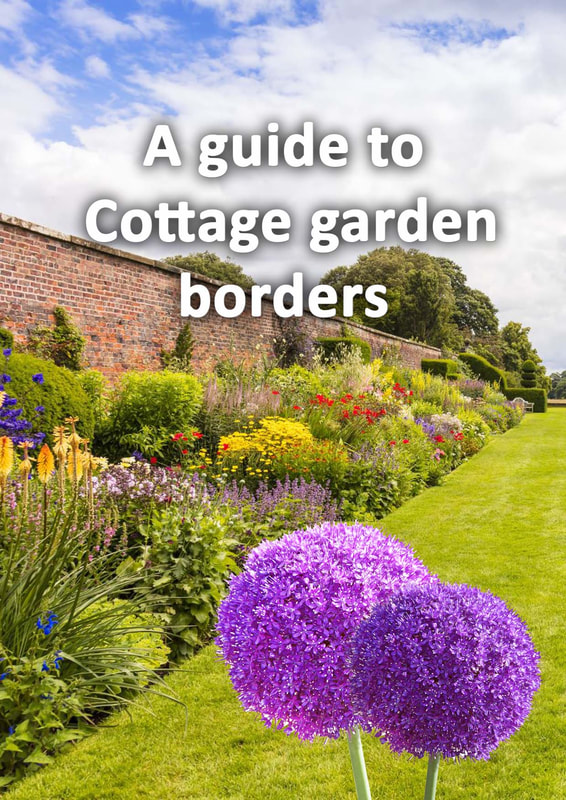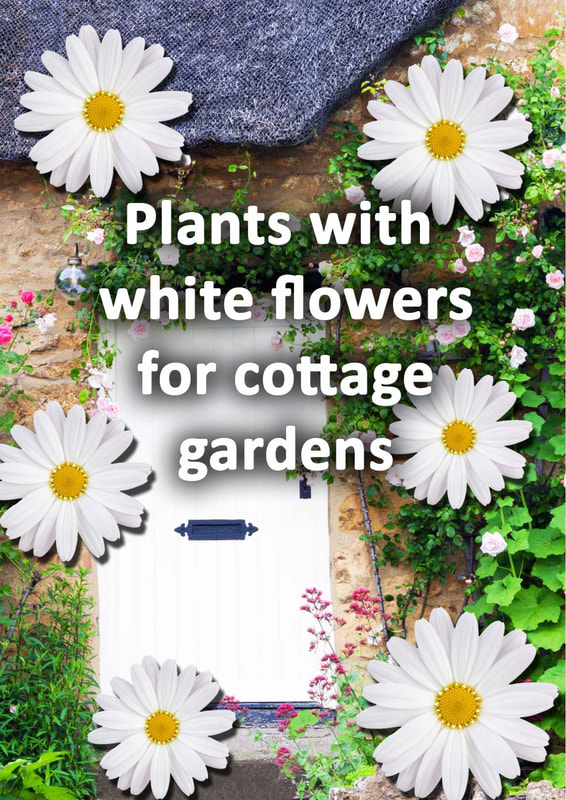|
This article contains affiliate links
English cottages enclosed with rustic stone walls and bursting with colour are a thing of wonder. Such beautiful scenes are a nostalgic glimpse of a rural way of life which endured for centuries.
Cottage gardens do not only appeal to our visual senses but emotional senses too. In a world of mass production and geometry cottage gardens give us something rugged and traditional. It no surprise that English, Cottage, gardens are world renowned and recreated all over the globe. However cottage garden plants are also loved in exactly the same manner.
Like other cottage elements there is an emphasis on resourcefulness and the contextual.
Buildings and landscapes evolved with what you had to hand instead of what you could mass produce. Similarly cottage garden plants would often have some form of utility. Borders were planted with masses of perennial flowers and allowed to grow in an unrestrained manner. In cottage communities of the past spare time came at a premium! Gardeners placed an emphasis on plants which did not have to be planted every year. Hence there was always an appreciation of flowering shrubs and perennials within cottage borders. A need to produce local commodities for the kitchen led an abundance of cut flowers, herbs, fruits and vegetables. In this article I will list some of the best plants for cottage gardens money can buy. Trees
Historically cottage gardens rarely had large and expanse areas of garden space. However when there was room it was very popular to grow fruit trees. These could provide extra delicacies in the kitchen as well as making jams and preserves.
Apples
Apples are heavy producers and very reliable croppers. The great thing about apples is you do not need huge trees to harvest a large crop. These were staple trees for cottage gardens and can be pruned in multiple shapes.
Pears
Pears were also a very popular fruit grown in the cottage garden. Originally from southeast Europe they are less easy to grow but do well against a sunny wall. These can also be trained against trellis and along wires.
Plums
Plums are an extremely productive fruit tree when established and can be eaten fresh, dried, or made into jams, chutneys or wine! These small trees are also easy to prune into any shape or form. These are great for small cottage gardens and have excellent spring blossom.
Cherry
Cherries are one of nature’s little delicacies and were very popular in historical cottage gardens. Cherry trees have amazing blossom in spring and can be made into fantastic deep red jams and pies. These trees are also very manageable for small sites typically staying around 4 metres tall.
Quince
Quinces are a fantastic fruit and great for making fresh summer drinks and deserts. During spring they have large, five lobed, white and yellow flowers. Originally from Asia these trees do like sunny warm conditions so a sheltered spot is always best.
Medlar
Medlars are small, beautiful trees that were once more common in cottage gardens across Britain. Due to their small, ping pong, sized, fruits they were not favoured for commercial production. It has attractive blossom, great autumn colour and makes a tastey jelly that can be enjoyed with meats.
Mulberry
Mulberries are another historical tree which fell out of favour during the past 150 years. Its small fruits are not easy to harvest commercially but are a joy and store easily. The berries of this tree can be made into wine and the leaves can also be used in cooking.
Figs
Figs are thought more of a Mediterranean fruit tree but did become popular in Victorian times. These tropical looking trees became popular for growing against sunny walls in Britain and cottage gardens were no exception.
Shrubs
Cottage gardens are famous for their wide borders full of dazzling colours and flowers. However these beds were typically backed by a range of interesting shrubs. Cottage gardens would use shrubs for seasonal blooms, scent and striking autumn colour. We have listed some of the typical cottage garden shrubs below.
Hydrangea
Hydrangeas are famous for their circular clumping foliage and huge flowers. These wonderful flowering shrubs can provide lasting summer displays and are very hardy. These are perfect as a backdrop to flower borders or in a more prominent position.
Roses
What cottage garden would be without roses? Roses can provide a continuous flow of blooms throughout the growing season and come in many varieties. Climbing varieties are perfect for arches or external walls.
Elder
Elderberry is a robust and medium sized woodland shrub native to Europe. Traditionally elders were favoured in cottage gardens for their many uses. Elderflowers were used to flavour drinks and really capture the taste of early summer. Their berries are also delicious and perfect for jams.
Fuchsia
This small shrub is favoured for its arching stems and striking bright, bell like flowers. Originally from South America these beautiful shrubs seem to be able to work well within any garden scheme.
Witch-hazel
Witch-hazels are a very famous shrub in folklore and have fantastic, autumn colour. The best thing about this shrub is its unusual flowers and scent in late winter. It has the ability to fill a whole area with its deep and extraordinary scent.
Daphne
Daphne’s are beautiful little shrubs with small blooms and perfect for the front of cottage garden borders. The best part about Daphnes is they are winter flowering giving off a pleasant aroma.
Lavatera
Often known as the ‘tree Mallow’ Lavatera have mallow like blooms and hibiscus like petals. These small shrubs are perfect for flower borders providing continuous flowers during the summer months.
Choisya
Choisya is a very popular shrub both in private gardens and in public landscapes. This attractive, evergreen shrub has decorative foliage and delicate white flowers. Its fine textured foliage makes it a great backdrop for other plants within the flower border.
Philadelphus
Also known as 'Mock orange' this glorious shrub is famous for its striking white flowers and amazing scent. The summer flowering shrub can make whole areas smell of its sweet, orange aroma. Philadelphus is a great allrounder and can be easily pruned into any form.
Buddleja
Buddleja is a medium sized flowering shrub native to central Asia. Sometimes called butterfly bush it is extremely popular with butterflies and other insects. It is so resilient it has been seen growing out of roofs in the centre of cities. The shrub can add some height, interest and wildlife value to the cottage garden border.
Camellia
Camellias are famous for their shiny, dark foliage and radiant rose like flowers. They can be temperamental and do like acidic soil. However if you can grow them they make a welcome addition to the cottage garden.
Viburnum
Viburnams are a broad range of different shrubs but are all beautiful and suitable for cottage gardens. Viburnum tinus is a very attractive evergreen viburnum and botnantense has fantastically scented winter flowers.
Currents
Currents are small fruit bushes and were very typical of cottage gardens in historical times. Not only are these bushes productive they also have attractive blooms and attract wildlife. The most common are red and black currents.
Strawberry tree
This evergreen shrub is a bit of a novelty wherever it is planted. It has bright red, strawberry looking fruits which taste amazing! These shrubs do need acidic soil but can be grown in pots of ericaceous compost.
Ceanothsis
Ceanothis is an evergreen shrub with fantastic, radiant blue flowers. It can thrive in a range of conditions but prefers a sheltered and sunny site. With careful pruning it can pretty much be shaped into any form, even a low lying hedge.
Bay
Most of us are familiar with bay leaves as they are extensively used in cooking. However Bays are also very decorate shrubs with shiny evergreen foliage and small white flowers. They can make great topiary pieces and small hedges. Perfect for cottage garden displays!
Perennials
Perennials are perfect for Cottage garden borders, grown on mass these plants can create a meadow effect. Traditionally cottage gardens were full of flowering perennials which come up every year. This was ideal for busy rural workers as there was no need to replant every season.
Verbena Bonariensis
This tall, flowering, perennial has deep, purple, globe like, flowers which sway in the breeze. These are perfect for creating movement in the cottage border or around a focal point. Once planted Verbena will come up every year and are surprisingly robust once established.
Hellebores
Hellebores are a low growing perennial which can put up with shady conditions. Originating from woodland environments these plants have strikingly beautiful blooms in the heart of winter. Once established, Hellebores can be a pleasant sight in the depths of miserable winters.
Golden rod
Golden rod is a one metre tall perennial with sprays of yellow blooms in midsummer. This plant is technically a wildflower being native to Europe. It can be found on waste ground and can also attract beneficial insects.
Aster
Aster is a very common favourite amongst many gardeners and looks amazing in the cottage garden. This perennial is famous for its robust nature and attractive blue, daisy like flowers. This plant can easily be lifted and divided every year for new stock.
Lupines
Lupines are truly striking, flowering plants which have clusters of decorative flowers in early summer. The plants are closely related to the bean family and consequently have similar flowers. These flowers can grow to around one metre and provide a great addition to cottage garden borders.
Holyhocks
Holyhocks are a classical favourite of the English cottage garden and come in a variety of colours. Originally bred from the mallow these plants are hardy and robust. These perennials can grow to impressive heights with spears of large flowers.
Echinacea
Also known as the Coneflower Echinacea is a member of the daisy flower and native to North America. This plant is generally well known for its medicinal value but packs a punch visually. With a traditional daisy look but with a large size and enchanting blue or purple colour it’s a must!
Delphinium
Delphiniums are tall perennial plants with impressive flower spikes. These are perfect for cottage gardens with their attractive large and frilly flowers. These have a similar look to hollyhocks and also come in a wide variety of colours.
Hostas
Hosta's are a classic perennial and loved by all sorts of gardeners all across the world. Their large, attractive leaves make them a decorative choice for that shady corner. These are perfect for cottage borders shaded by the home. However that is if the slugs do not get to them first!
Ferns
If you have a shady cottage garden then you may wish to consider some fern varieties. Perennials like ostrich fern can be perfect for under tree canopies and can even provide an edible crop. Ferns are also great for shady, wet walls and woodland areas.
Iris
Iris is an attractive perennial plant which comes in numerous types and varieties. These have sword like foliage and large attractive frilly flowers. These plants grow and spread from robust rhizomes under the soil. Their robust growing habit makes them a great low maintenance plant for cottage gardens.
Campanula
Also known as Bellflowers Campanula is a low growing plant with attractive bell shaped flowers. It is perfect for growing over the walls of raised beds and at the front of borders. Due to its dense growing nature it is ideal as a ground cover plant.
Daylilies
Daylilies are delightful perennial plants with radiant star shaped flowers. The blooms only lasts 1 day hence the name daylily. These plants have been grown in Europe for centuries and were also popular in cottage gardens.
Peonies
The one thing which always makes cottage gardens memorable is their fantastic array of flowers. When it comes to impressive blooms Peonies top the lot. These plants come up every spring and explode in colour around June time. Their exaggerated rose looking blooms are unforgettable.
Crocosmia
Crocosmia are a clump forming, summer flowering, perennial bulb, plant with exotic looking flowers. These plants have become incredible popular for their amazing aesthetics while requiring very little work. Corcosmia once established can create a dense ground cover crowding out even aggressive weeds.
Cranesbill
Cranesbill is a hardy variety of geranium with decorate foliage and beautiful flowers. These can tolerate a wide range of conditions and form an effective ground cover. The great thing about these little plants is they flower all summer long.
Alchemilla mollis
Alchemilla or 'Ladys Mantle' is a herbaceous perennial with aluminous, green, foliage and a spreading form. Very popular in dry garden schemes this plant is originally from the mountainous regions of the Balkans. It offers attractive foliage and flowers to borders and requires very little maintenance.
Phlox
Phlox is a species of flowering plant with over 60 distinct varieties worldwide. Originally from North America these plants are accustomed to a temperate climate. These plants are famous for their masses of scented flowers which look great in the cottage flower border.
Biennials
Biennials are plants which will typically last two seasons. Generally speaking these plants will be seeded one year and then flower in their second season before dying off. These plants generally self seed prolifically, due to the nature of their life cycles. Historically biennial plants were very typical in cottage garden flower borders.
Digitalis
Commonly known as 'Foxglove' Digitalis is a much loved woodland biennial plant. Well known for its medicinal qualities this plant has tall stems of bell shaped flowers. The plant is very shade tolerant and popular with bees.
Dianthus
Also known as 'Carnations' these small flowering plants are perfect for setting off garden borders. Generally these flowers are low growing with vibrant flowers. There are so many hybrids of these plants which provide a wide spectrum of variability.
Wallflower
Wallflowers are extremely attractive plants which will flower in early spring. These are actually apart of the cabbage family and have similar flowers. However wall flowers are much more colourful and delicate providing early season blooms.
Common evening primrose
Cottage gardens are famous for planting useful and medicinal plants. What could be more relevant in this regard than evening primrose? However this is not all it has going for it as it has very attractive yellow flowers. This plant is also very popular with bees and butterflies.
Teasel
Teasel is famous for its striking form and unusual flowers which are popular in flower arranging. This plant can add dramatic shapes to the cottage garden border and provides food for wildlife.
Aquileia
Aquileia is a small flowering plant which is very common and recognised due to its self seeding nature. It is very common for these, once planted, to thrive in a garden for many years. They have unusually patterned foliage and small colourful flowers.
Nicotiana
Famous for being a part of the tobacco plant family this species is famous for its amazing scent. Nicotiana has now been bred into many variations and has interesting, tube like flowers. These flowers are really effective for adding colour and fragrance to the cottage garden.
Herbs
As cottage gardens were traditionally places to grow produce for the kitchen they had their far share of herbs. Herbs have not only been grown in cottage gardens for food but also teas and medicines. Below we have listed some of the more typical garden herbs which are very popular in cottage gardens.
Mint
Mint is a historical favourite of the gardens throughout the world. Not only does this plant have many uses it also comes in a variety of different types. From spearmint to peppermint this herb is perfect for teas and even pest control.
Lemon balm
Lemon balm is very well known for its strong lemon fragrance. However it is often not utilised as much as it could be. When dried this herb makes a delicious bed time tea which is extremely sleep inducing. Not only does this perennial smell great it also looks very attractive.
Thyme
What herb garden would be without a classic favourite such as thyme? Thyme is extremely rich in essential oils which make it smell and taste great. Thyme can be used to season meats and also makes a great ground cover in the garden.
Pennyroyal
Pennyroyal is a less well known member of the Mint family but historically a very useful herb. The Romans referred to this plant as the mosquito plant as it was used to repel flying insects. Pennyroyal has an extremely strong peppermint aroma which can ward off garden pests.
Oregano
Oregano is a perennial herb normally associated with Mediterranean cooking and popular on pizza. There are many different varieties of oregano all with very different aromas. Some Eastern Mediterranean varieties even taste spicy like chilly.
Parsley
Parsley is a favoured herb and one which regularly features in kitchen recipes. With very long tap roots parsley penetrates deep into the soil drawing up essential nutrients. This has led to it gaining a reputation for being extremely beneficial to health.
Rosemary
Rosemary is a small and attractive evergreen shrub as well as being a favourite herb. This also makes it an effective landscaping plant. Rosemary can actually be planted as a low hedge which provides fresh herbs when trimmed. This plant was very common in cottage gardens of the past and is a must have today!
Annuals
Annuals are plants which only grow for a single year and generally germinate in the spring. These plants are naturally prolific at sowing themselves and once established will persist for years. This makes traditional cottage garden annuals relatively maintenance free. They are also very attractive plants providing radiant blooms throughout the season.
Poppies
Poppies are an extremely beautiful flowering plant which is common in agricultural landscapes. The famous, red, 'Corn Poppy' actually needs ground disturbance to germinate. This is why they easily colonise corn fields and ploughed land. There are many varieties of poppy which all look great in cottage gardens.
Forget me not
Forget me not’s are small, low growing annuals which have a very attractive, small, flower. These are typical of so many gardens and can appear without even being planted. These plants like moist but well drained soil and are generally not very fussy.
Nasturtium
Nasturtiums are famous for their large bell like flowers and irregular shaped leaves. These small annuals have the ability to flower pretty much all season and are not fussy. Nasturtiums come in a wide variety of colours and their foliage and flowers are edible.
Cornflower
Also known as Bachelors button Cornflowers are small, annual plants with a deep blue flower. This wildflower is typical of meadows but is also at home in the flower border. Cornflowers are a true country plant and perfect for cottage garden planting displays.
Sunflowers
Sunflowers are stunning plants which can grow to an amazing height in a single season. Some giant varieties can grow over 10 foot tall! Their height and large flowers make them very a stunning addition to cottage gardens.
Snapdragons
Snap dragons are a favourite flower of the cottage garden and popular with bees and children! These colourful flowering plants are easy to grow and look amazing at the front of a cottage garden border.
Climbers
Cottage gardens often seek to add vertical foliage to garden walls and pergolas. It is very common to see old cottages with ornamental roses and grapevines growing on a sunny wall. This adds to the simplistic and rustic charm of cottage gardens. Below I have listed some of the best and most typical cottage garden climbers.
Honeysuckle
Honeysuckle is a well known woodland plant native to Europe; however it has now spread around the world. This popular climber is favoured for its attractive flowers which emit a pleasant scent. Honeysuckles are quite tolerant of difficult growing conditions and can thrive in semi shade.
Wisteria
Wisteria is very well known for its hanging clusters of pale purple flowers. Native to china this robust vine has become popular in many gardens around the world. This vine looks particularly charming grown up the side of cottages and cascading over door entrances.
Grapevine
Grapevines have always been popular, cottage garden, plants and grown along sunny walls and boundaries. Grapevines were regularly planted for their use in village wine making. As the leaves of vines are also edible they were very useful for subsidising the kitchen.
Boston ivy
Boston ivy is a remarkable climber with jagged 5 lobed leaves with exceptional autumn colour. This climber is famous for tuning whole buildings bright red during the fall! Boston ivy has become a very popular cover plant in rural settings and around old country cottages.
Climbing hydrangea
Climbing hydrangeas are more trailing shrubs than climbers but no less effective in the cottage garden. These shrubs will create a bushier coverage than other climbers and perfect for around windows and doors. During the summer they are covered with attractive, white, flowers.
Climbing rose
If there is one typical climber of the cottage garden it is the climbing rose. More historical cottages would grow more wild rambling roses such as Rosa Carnea and Rosa Rugosa. These are still available today and good for the harvest of rose hips and wildlife. However more modern climbing roses with classic red, yellow and white flowers are also perfect for cottage gardens.
Jasmine
Cottage gardens are particularly famous for their use of scented plants. Many climbers with scented flowers were grown over arches and pergolas to surround you with sent. One of the best climbers for emitting such fragrance is the star jasmine. This summer flowering jasmine emits a classic, sweet, jasmine fragrance.
Clematis
Clematis is a favourite climber within cottage gardens and favoured for their fabulous flowers. With delicate foliage these climbers are less aggressive and perfect for patio trellises and arches. Their hypnotic flowers make them irresistible to include in your very own cottage garden.
Thank you for reading our article on cottage garden plants, Why not also read our article on how to create a cottage garden here. If you are planning on creating your cottage garden yourself why not visit our landscaping resources page here.
'As an Amazon associate I earn from qualifying purchases'
0 Comments
Leave a Reply. |
The Author
|
Landscaping services across Buckinghamshire, Amersham, Aylesbury & High Wycombe
Hyde Heath, Amersham, Buckinghamshire |
|













